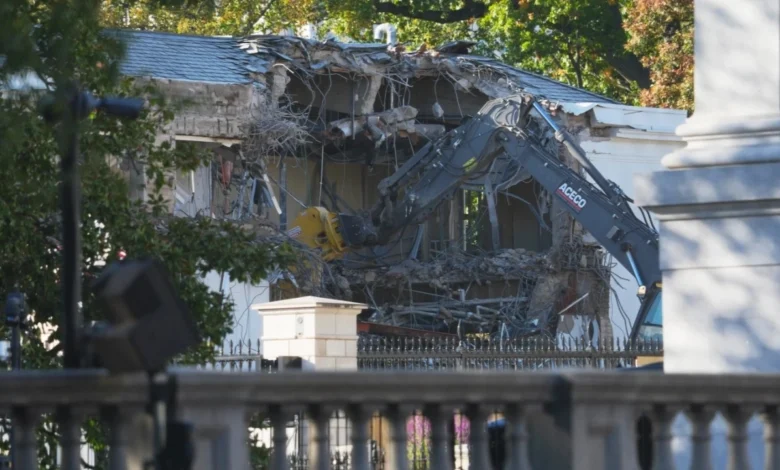
Historic East Wing Faces Complete Teardown as Ballroom Plans Expand
The White House grounds will soon look very different as Trump’s East Wing renovation project kicks off. The project will demolish the White House’s East Wing, built in 1902 and modified in 1942, to create a massive 90,000-square-foot ballroom. This new structure will be larger than the White House building itself, which spans only 55,000 square feet.
The construction team has already started the demolition process, though earlier statements claimed it would “not interfere” with the existing building. The project could finish the teardown phase this weekend. The project’s cost has also jumped from its original $200 million estimate in July to $300 million now. The new ballroom’s design will let up to 999 guests walk straight from the White House East Room into the expanded space. The construction crews broke ground on this controversial project Monday, and news outlets quickly shared images of the demolition work.
Trump Orders Full Demolition of East Wing for Ballroom Expansion
Image Source: India Today
Construction crews started tearing down the East Wing facade on Monday. This revealed a dramatic shift in the east wing renovation plans. The Trump administration officials later confirmed that crews would demolish the whole East Wing “within days”.
Demolition begins despite earlier claims of minimal interference
Heavy machinery tears into the historic structure and rips away large chunks of the building. Trump’s July statement claimed the new ballroom would “not interfere with the current building” and would be “near it, but not touching it”. Trump addressed this contradiction in the Oval Office by telling reporters that the East Wing “was never thought of as being much; it was a very small building”. “To do it properly, we had to take down the existing structure,” he explained.
White House confirms entire East Wing will be replaced
White House officials confirmed they will “modernize and rebuild” the “entirety” of the East Wing as part of the east wing white house renovation. The planned ballroom will change the White House footprint completely. The new structure will span 90,000 square feet – this is a big deal as it means that the size of the White House residence at 55,000 square feet. The cost of the trump east wing renovation has gone up, with Trump now putting the project at $300 million, up from the original $200 million announced in July.
Construction expected to finish initial phase within weeks
The east wing construction moves faster than expected. Administration officials believe crews will complete the demolition within two weeks. Some reports suggest it could end as early as this weekend. The first lady and her staff have temporarily moved from their traditional East Wing offices during what White House Press Secretary Karoline Leavitt called the “modernization” process.
The White House says the ballroom will be ready before Trump’s term ends in January 2029. Critics question this timeline. All the same, construction continues quickly. The White House claims demolition work needs no approval from the National Capital Planning Commission since the commission only oversees new construction.
Trump Defends Renovation Amid Transparency Concerns
Image Source: People.com
Questions about the east wing renovation continue to grow. President Trump defended the project on Wednesday and dismissed criticism about the lack of public review process. During an Oval Office event, he pushed back against claims that his administration had not shared enough details about these massive renovation plans.
President claims transparency despite lack of public review
“I haven’t been transparent? Really? I’ve shown this to everybody that would listen,” Trump insisted when questioned by reporters. Several preservation organizations raised concerns as the project moved forward without proper review. The National Trust for Historic Preservation asked for a pause in demolition and urged the White House to “go through the legally required public review processes”. The Society of Architectural Historians also expressed “great concern” about the ballroom project and wanted a more thorough review process.
Architectural renderings and mockups shown to press
Trump displayed architectural renderings and a White House model with the new ballroom at the Wednesday Oval Office meeting. The mockups showed Louis XIV-style interior designs that looked like the Mar-a-Lago’s ballroom. “You see it goes beautifully with the White House,” Trump proclaimed while showing off the designs. “I mean, the mix is beautiful”. These plans still need submission to the National Capital Planning Commission, though the White House said they will be “soon when it is time”.
Trump says East Wing was ‘not much left from the original’
Trump minimized the East Wing’s historic significance to justify the complete demolition. “We determined that after really a tremendous amount of study with some of the best architects in the world, we determined that really knocking it down, trying to use a little section, you know, the East Wing was not much. It was not much left from the original,” he stated. He claimed the structure went through multiple renovations, which made it “very, very much changed from what it was originally”. The project’s cost has now increased to $300 million from the $200 million announced in July.
Experts Question Legality and Oversight of East Wing Renovation
Image Source: Yahoo News Canada
Legal experts have concerns about the east wing white house renovation’s approval process. The project continues without following the standard procedures that federal buildings need for major alterations.
NCPC’s role and Will Scharf’s dual position
The National Capital Planning Commission (NCPC) faces an unusual situation in its role of overseeing federal construction projects. The White House appointed Will Scharf, Trump’s White House staff secretary, to lead the commission in July with two other Trump loyalists. His role as both NCPC chairman and staff secretary raises questions about conflicts of interest. Scharf defends his position: “I’ve played no role in the planning process here at the White House for the ballroom, and I take my duties as NCPC chairman very seriously”.
National Trust for Historic Preservation calls for pause
The National Trust for Historic Preservation reacted to the quick demolition with a formal letter on Tuesday. They asked the administration to “pause demolition until plans for the proposed ballroom go through the legally required public review processes”. The planned structure’s massive scale worries them most. At 90,000 square feet, it would “overwhelm the White House itself,” which covers only 55,000 square feet.
White House claims demolition doesn’t require approval
The White House maintains that NCPC approval applies only to “vertical construction”. Scharf stated during a September meeting that the commission “has long denied that it has jurisdiction over demolition and site preparation work”. Bryan Green, a former NCPC commissioner, disagrees with this stance: “In regular federal projects, deliberation happens before anything is demolished”.
Funding Sources Raise Ethical Questions Over Donor Influence
Image Source: Tyla
Financial complexities around Trump’s east wing renovation have ignited serious ethical debates. The president claims private funding will cover this massive project entirely.
Trump and anonymous donors claim to fund $300M project
The White House confirms the ballroom project will cost $300 million, with funding from Trump and what he calls “many generous Patriots, Great American Companies, and, yours truly”. Trump has updated the cost estimate and told reporters the ballroom would cost “about $300 million”, which is substantially higher than initial projections. The demolition work moves faster now, but the White House has only confirmed that “nearly $200 million has so far been pledged”.
Concerns over ‘pay-to-play’ access raised by ethics experts
Ethics watchdogs have sounded alarms about potential conflicts of interest. Columbia law professor Richard Briffault points out that the donors have done “significant business with the federal government”. Former Bush White House ethics lawyer Richard Painter calls the ballroom an “ethics nightmare”. He argues this creates a system where companies might seek the president’s favor through donations. CREW’s Noah Bookbinder warned that “Donald Trump has made very clear over the years that he does appreciate people paying tribute to him”.
YouTube’s $22M contribution linked to legal settlement
Alphabet will provide $22 million through a legal settlement after Trump’s lawsuit over his YouTube account suspension following January 6, 2021. Court documents reveal these funds will go “to the Trust for the National Mall, a 501(c)(3) tax-exempt entity”.
Donor dinner included major tech and defense executives
The White House hosted potential donors at a dinner where some attendees asked if $25 million was “an appropriate donation”. The guest list included representatives from Amazon, Apple, Caterpillar, Coinbase, Comcast, Google, Lockheed Martin, Meta, Microsoft, Palantir, and T-Mobile. Many of these companies hold lucrative government contracts, with Palantir and Lockheed Martin maintaining billions in Defense Department contracts.
Trump’s East Wing renovation stands as one of the biggest physical changes to the White House in recent times. The complete demolition of the historic structure breaks earlier promises of minimal changes. This new 90,000-square-foot ballroom, almost twice the size of the White House, will change the executive mansion’s look for generations to come.
The project faces ongoing questions about proper oversight and approval. The administration has skipped the standard review process that federal construction usually needs, especially with historic buildings. Will Scharf’s role raises concerns as he serves both as White House staff secretary and chairman of the National Capital Planning Commission. His dual position creates potential conflicts of interest in the approval process.
The project’s cost has jumped from $200 million to $300 million, which is a big deal as it means the initial budget wasn’t enough. Trump says private sources are funding the work, but ethics experts warn about “pay-to-play” risks where donors might expect special treatment. Many companies with big government contracts show up as the project’s main supporters.
Construction teams are moving fast, and they plan to finish demolition in weeks. This quick timeline worries preservation groups and architectural historians who want more careful planning. The East Wing, built in 1902 with its last changes in 1942, holds deep historical value whatever Trump thinks about it.
These changes show Trump’s unique way of being president – bold, controversial, and free from traditional limits. His supporters might see this renovation as making the White House grander, but critics view it as going too far. They believe it hurts the building’s history and raises questions about presidential power and private influence. Soon, Americans will see if this huge ballroom becomes a proud addition or a symbol of executive overreach.






